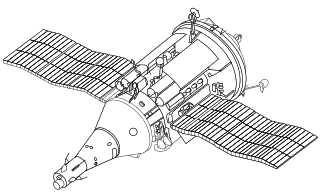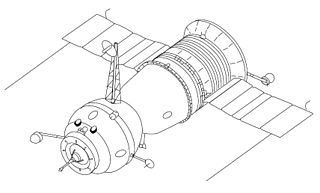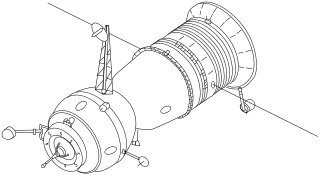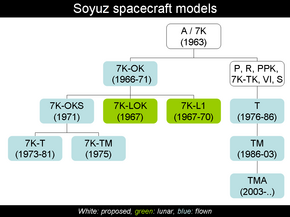
The Soyuz programme is a human spaceflight programme initiated by the Soviet Union in the early 1960s. The Soyuz spacecraft was originally part of a Moon landing project intended to put a Soviet cosmonaut on the Moon. It was the third Soviet human spaceflight programme after the Vostok (1961–1963) and Voskhod (1964–1965) programmes.

The Salyut programme was the first space station programme, undertaken by the Soviet Union. It involved a series of four crewed scientific research space stations and two crewed military reconnaissance space stations over a period of 15 years, from 1971 to 1986. Two other Salyut launches failed. In one respect, Salyut had the task of carrying out long-term research into the problems of living in space and a variety of astronomical, biological and Earth-resources experiments, and on the other hand the USSR used this civilian programme as a cover for the highly secretive military Almaz stations, which flew under the Salyut designation. Salyut 1, the first station in the programme, became the world's first crewed space station.

Soyuz 1 was a crewed spaceflight of the Soviet space program. Launched into orbit on 23 April 1967 carrying cosmonaut colonel Vladimir Komarov, Soyuz 1 was the first crewed flight of the Soyuz spacecraft. The flight was plagued with technical issues, and Komarov was killed when the descent module crashed into the ground due to a parachute failure. This was the first in-flight fatality in the history of spaceflight.

Soyuz is a series of spacecraft which has been in service since the 1960s, having made more than 140 flights. It was designed for the Soviet space program by the Korolev Design Bureau. The Soyuz succeeded the Voskhod spacecraft and was originally built as part of the Soviet crewed lunar programs. It is launched on a Soyuz rocket from the Baikonur Cosmodrome in Kazakhstan. Between the 2011 retirement of the Space Shuttle and the 2020 demo flight of SpaceX Crew Dragon, the Soyuz served as the only means to ferry crew to or from the International Space Station, for which it remains heavily used. Although China did launch crewed Shenzhou flights during this time, none of them docked with the ISS.

Salyut 6, DOS-5, was a Soviet orbital space station, the eighth station of the Salyut programme. It was launched on 29 September 1977 by a Proton rocket. Salyut 6 was the first space station to receive large numbers of crewed and uncrewed spacecraft for human habitation, crew transfer, international participation and resupply, establishing precedents for station life and operations which were enhanced on Mir and the International Space Station.

Salyut 7 was a space station in low Earth orbit from April 1982 to February 1991. It was first crewed in May 1982 with two crew via Soyuz T-5, and last visited in June 1986, by Soyuz T-15. Various crew and modules were used over its lifetime, including 12 crewed and 15 uncrewed launches in total. Supporting spacecraft included the Soyuz T, Progress, and TKS spacecraft.
Soyuz T-13 was a Soyuz mission, transporting personnel to the Soviet space station Salyut 7. The eighth expedition to the orbital station, the mission launched from Baikonur Cosmodrome, atop a Soyuz-U2 carrier rocket, at 06:39:52 UTC on June 6, 1985. It is of note because it marked the first time a spacecraft had docked with a 'dead' space station, and the first time such a station had been returned to operational status following repairs.

The TKS spacecraft was a Soviet spacecraft conceived in the late 1960s for resupply flights to the military Almaz space station.

The Soyuz-TM were fourth generation (1986–2002) Soyuz spacecraft used for ferry flights to the Mir and ISS space stations. The Soyuz spacecraft consisted of three parts, the Orbital Module, the Descent Module and the Service Module.

Soyuz 7K-OKS is a version of the Soyuz spacecraft and was the first spacecraft designed for space station flights. Its only crewed flights were conducted in 1971, with Soyuz 10 and Soyuz 11.

The Soviet Union planned several military Soyuz spacecraft models. These versions were named Soyuz P, Soyuz PPK, Soyuz R, Soyuz 7K-VI, and Soyuz OIS (Orbital Research Station). However, none of the spacecraft ever flew in space.

The second generation of the Soyuz spacecraft, the Soyuz 7K-T, comprised Soyuz 12 through Soyuz 40 (1973–1981). In the wake of the Soyuz 11 tragedy, the spacecraft was redesigned to accommodate two cosmonauts who would wear pressure suits at all times during launch, docking, undocking, and reentry. The place of the third cosmonaut was taken by extra life-support systems. Finally, the 7K-T, being intended purely as a space station ferry, had no solar panels, instead sporting two large whip antennas in their place. As a result, it relied on batteries which only provided enough power for two days of standalone flight. The idea was that the Soyuz would recharge while docked with a Salyut space station, but in the event of a docking or other mission failure, the crew was forced to power off everything except communications and life support systems until they could reenter.

Progress 7K-TG, was a Soviet uncrewed spacecraft used to resupply space stations in low Earth orbit. Forty three flew, delivering cargo to Salyut 6, Salyut 7, and Mir. It was the first version of the Progress spacecraft to fly, and spawned later derivatives including the Progress-M which replaced it, and the later Progress-M1.

Progress 2 was an unmanned Progress cargo spacecraft launched by the Soviet Union in 1978 to resupply the Salyut 6 space station. It used the Progress 7K-TG configuration, and was the second Progress mission to Salyut 6. It carried supplies for the EO-2 crew aboard Salyut 6, as well as equipment for conducting scientific research, and fuel for adjusting the station's orbit and performing manoeuvres.

Docking and berthing of spacecraft is the joining of two space vehicles. This connection can be temporary, or partially permanent such as for space station modules.
Sistema Stykovki i Vnutrennego Perekhoda, SSVP is a docking standard used by Soviet and Russian spacecraft, sometimes called RDS for Russian Docking System. It has been used on all variants of Soyuz other than the Soyuz 7K-L3 and early flights of the Soyuz 7K-OK, as well as Progress, TKS, ATV, and on all Soviet and Russian space stations.

Soyuz 7K-L1E was a Soviet uncrewed modified Soyuz 7K-L1 spacecraft. Also called a dummy Soyuz 7K-LOK. Two were built, one Soyuz 7K-L1E was successfully launched into Low Earth Orbit on Proton rocket and is known as Kosmos 382. The other Soyuz 7K-L1E was placed on a N1 rocket, which failed at launch. The Soyuz spacecraft was first used in 1967 as the main crewed spacecraft and is still in use. Many Soyuz variations have been built and the Soyuz 7K-L1E was an uncrewed variation.

Soyuz 7K-T-AF is a version of the Soyuz spacecraft and was the first spacecraft designed for space station flights, a dedicated science mission. Its only crewed flight was conducted in 1973 with Soyuz 13 of the Soyuz programme.


















